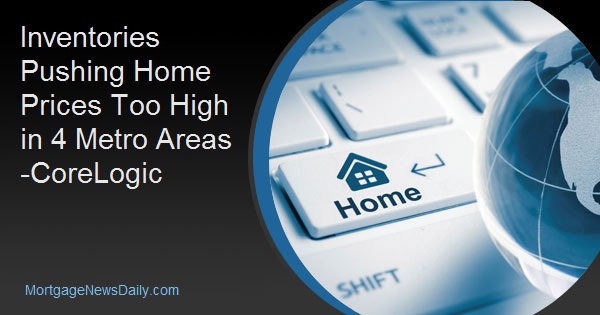Home prices chalked up another healthy gain in June. CoreLogic reports that its Home Price Index (HPI) marked a 6.7 percent increase compared to the June 2016. This was up from the 6.6 percent May-to-May change, but was still the second smallest annual growth so far in 2017.
On a month to month basis the HPI appreciated 1.1 percent, a slight dip from the 1.2 percent gain in May. A small slowing of month-over-month appreciation has been typical of most of the price indices over the last few months.
CoreLogic notes that national home prices have risen by almost 50 percent since its HPI's low point in March 2011. Annual increases over the first six months of 2017 have averaged 6.85 percent and the monthly gains 1.2 percent.
On the downside of the price increases, CoreLogic now considers four of the top 10 metropolitan markets by population to be overvalued. Identified by the major city or cities in each, they are Denver, Houston, Miami-Miami Beach, and Washington, DC. CoreLogic identified these areas by comparing current home prices to their long-run sustainable levels as supported by local market fundamentals such as disposable income. An overvalued market is defined as one in which home prices are at least 10 percent higher than that level, while an undervalued market is one in which home prices are at least 10 percent below the sustainable level.
Frank Martell, president and CEO of CoreLogic said, "Home prices are marching ever higher, up almost 50 percent since the trough in March 2011. With no end to the escalation in sight, affordability is rapidly deteriorating nationally and especially in some key markets such as Denver, Houston, Miami and Washington. While low mortgage rates are keeping the market affordable from a monthly payment perspective, affordability will likely become a much bigger challenge in the years ahead until the industry resolves the housing supply challenge."
Wahington led all states with an annual price escalation of 12.7 percent followed by Utah at 10.7 percent. Other high gainers were Colorado (9.2 percent), Idaho (9.1 percent), and Oregon (9.0 percent.) Alaska lost ground, with an annual decline of 0.6 percent. Four other states, Delaware, Connecticut, and West Virginia had minimal increases, ranging from 0.3 to 0.9 percent
Like most price and sales reports, CoreLogic also cites the dampening effect of the record low inventories of available homes. "The growth in sales is slowing down, and this is not due to lack of affordability, but rather a lack of inventory," said Dr. Frank Nothaft, chief economist for CoreLogic. "As of Q2 2017, the unsold inventory as a share of all households is 1.9 percent, which is the lowest Q2 reading in over 30 years."
Looking ahead, the CoreLogic HPI Forecast indicates that home prices will increase by 5.2 percent on a year-over-year basis from June 2017 to June 2018. On a month-over-month basis, CoreLogic is looking for appreciation of 0.6 percent in its July 2017 report. The CoreLogic HPI Forecast is a projection of home prices using the CoreLogic HPI and other economic variables. Values are derived from state-level forecasts by weighting indices according to the number of owner-occupied households for each state.







